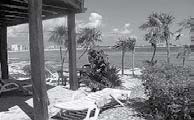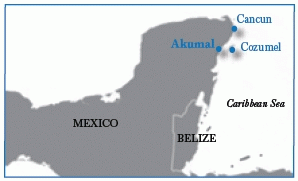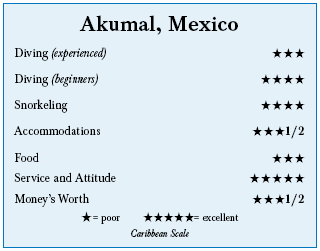Akumal, The Yucatan Peninsula, MexicoContents of this Issue: Akumal, The Yucatan Peninsula, Mexico NOAA Charges Florida Dive Boats with Illegal Spearfishing Did This Diver Fake His Own Death? Cabo, Cozumel, Dominica, Naples Sea Salt: Stan Waterman’s Story Ouch! Diver Spears Himself in the Groin Brownie’s Third Lung Recalls Its Hookah Air Compressors The Inadvertently Inflating Power Inflator Rebreather Firm Wins Its First U.S. Lawsuit The Major Cause of Dive Accidents What’s All the Fuss About Over Abalone? Thumbs Down: Gamboa Tours, Panama Editorial Office: Ben Davison Publisher and Editor Undercurrent 3020 Bridgeway, Suite 102 Sausalito, CA 94965 It’s not Cozumel diving, but it’s an alternative from the February, 2009 issue of Undercurrent
Dear Fellow Diver: Akumal is a Mayan word for the place where turtles gather, and it’s fitting. I was warned in advance that it was slow there, a step down from the rush of Cozumel to the north, both in diving and overall activities. But after 15 years of diving in Cozumel, hustle and bustle was not what I wanted and the notion of easy bathwater diving in a sleepy, little town appealed more than once again bumping elbows with boatloads of Carnival cruisers. There’s no rocketing along walls and reefs as in Cozumel, but it’s wrong to think mainland diving is a waste of compressed air. In my four full days of diving, there were turtles everywhere. On a gentle drift from Las Redes to Motorcycle, I hovered near a cleaning station watching a trio of tangs pick off parasites from a green sea turtle. It swam slowly away, not cowed by divers. Another hung out with me for several minutes. The highlight had to be a majestic, sixfoot green moray swimming about in the daytime. Its prominent dorsal fin made it seem even larger -- this wasn’t an eel you could get your hands around. It swam near me, obviously unafraid. Along with the turtles and the locals above water, it was on Akumal time.
An easy 80-minute drive south from the Cancun airport,
Akumal is really two
different towns with
one name. On the ocean
side of the coastal
highway, the tourist
area has seaside villas,
restaurants, dive
shops, an Internet
café, and grocery
marts. On the inland
side is the older,
quieter, whitewashed
part of town with a
pizza place, a simple
restaurant, and a walk-in joint where the locals buy barbecued
chicken. I rented Casa Zama, a cheerful seaside
villa that was a third of a mile walk
from town. It was secluded from the road by
a verdant garden with a lush bowered 40’
walkway from the parking area. Akumal has two main dive operations -- Akumal Dive Shop and Akumal Dive Center. I chose the former based on a friend’s recommendation about the friendly crew. Its shop is in the center of town, on the beach of Akumal Bay, and one gets a free locker and drizzly post-dive shower. On a whiteboard, staff lists the sites for the day’s scheduled trips (9:30 a.m., 11:30 a.m. and 2:30 p.m.). I signed up a half-hour in advance of each dive, then geared up. While divers officially assembled and carried their own gear to the boat about 50 yards away, the staff carried ladies’ tanks to and fro. Night dives depart at 5:30 p.m. with a four-diver minimum but on one diver’s last day, after he was unable to find three other divers for any night dives, they took him out anyway. Overall, Akumal Dive Shop was a smooth operation. Jesus, the manager, sported the cheer and hearty laugh of an entertainer. Betty managed the front desk efficiently, always asking if I was happy with everything, and the other pleasant employees handled their duties professionally. The boats are standard open skiffs, with tank holes in the seat running the boat’s length. No need for shade covers because the boats go directly back to the shop between dives, and sites were no more than eight minutes away. Most of my dives had four divers per boat. Getting on and off was easy -- I simply walked into knee-deep water where the boats were moored and climbed over the side, but a ladder was available for short-legged divers. After a synchronized backroll off the side and an OK to Freddy, the boat captain, we dropped down to the reef at La Tortuga. In the 80-foot visibility, sand patches mixed with ridged and grooved coral structures began at 40 feet. Divemaster Moises and Jim, happy to putt around the reefs, were quick to shake a rattle to show off a lobster, moray, turtle, ray or other critters. Moises, well-known for his critter-spotting, has a loyal customer following, while Jim is a transplanted Michigander. We dived as a loose group, staying in the divemaster’s visual range. It was never a marathon to rush around with cameras and boast about visual sightings later, like I’ve experienced at Cozumel. I prefer to peer into crevices for the little hidden critters, and here I found several corkscrew anemones with their attendants, nearly transparent Pederson’s cleaner shrimps. When it was time for the safety stop, Jim sent up a little fluorescent float so Freddy would be there when we popped up. One by one, we handed up our weight belts, BCs and then fins to Freddy and climbed the ladder. Maximum depths for morning dives were 90 feet, while the latter two averaged 50 feet. The waters were indeed a warm bathwater, averaging 82 degrees, and the air temperatures in December were a few degrees warmer. Most dives were an hour long with the aluminum 80s, but Nitrox is available and Akumal Dive Shop promotes its technical dives. The Yucatan is famous for its extensive, majestic cave systems called cenotes (pronounced say-NO-tay, and Mayan for “sacred well”), and Akumal is in the heart of cenote country, with some of the world’s most expansive cave systems just down the road. I sprung for the extra $75 to do the one-tank cenote dive that any basic openwater diver can do. The 75-degree fresh water (I had to adjust my weights) was so crystal-clear I felt like I was finning through air. Passing through the limestone stalactites and stalagmites covered with a jewel-like crystalline surface was like taking a trip to a grand, mysterious cathedral of diving, even though the depth only hit 30 feet.
Sometimes if there was even a little current, we would start at Motorcycle and get out at Las Redes, or go to Las Redes and go south or north. There weren’t many colorful fish except the occasional butterflyfish or common blue tang but even they were laid-back, uncaring if I passed over them going about their sand-making business. The hard corals were varied and healthy, but evidence of better days gone by was suggested by the forms of huge elkhorn coral, some the size of a Yugo, long since dead. I saw no big fish, unless one considers them to be scrawled filefish, a grouper and some gray angels, but others reported small sharks and eagle rays while I poked in crevices. Cho Mak and El Pueblito, two small grocery stores in “tourist” Akumal, offer an adequate food supply. My favorite eatery was an inexpensive food bar next to Cho Mak. A $3 bowl of excellent chicken soup was great after a night dive, tasty tacos were under $5, and burger and fries were $4. For another inexpensive dinner, head across the highway to Ultimo Maya, where the ceviche, beef la plancha, and chicken fajitas get high marks for flavor and good value. Cuevo el Pescador, specializing in fish, was more upscale but I made the mistake of ordering steak, which was overcooked. Another bad decision was to ask the Casa Zama manager to recommend a cook to prepare a dinner for my dive buddy and me at the villa. The cook charged me $60 for shrimp, rice, beans, and avocados, with no leftovers. A similar restaurant meal for two would have cost $30. If you feel like staying in a hotel, past reader reports have given good marks to the Hotel Akumal Caribe, and the beachfront condominiums at Las Casitas Akumal. Above water, plenty of Mayan ruins are nearby for side trips. Just 20 minutes south of Akumal is Tulum, the seaside “Walled City,” thought to be one of the most important cities of the Mayan era. Xcaret and Xel-Ha are Mayan ruins turned into eco-cultural theme parks, but locals told me that the latter has a “swim with the dolphins” feature and treats the dolphins badly. However, not all is perfect in this paradise, and the diving surely won’t meet the standards of Cozumel diehards. But every time I sat on the patio to enjoy the technicolor view of Half Moon Bay and gentle waves against the shore, I was glad I wasn’t up north, where the booming horns and shrieking mobs announce the arrival of more cruise ships. If you just want an easy place to dive with a decent amount of marine life and non-diving activities, a friendly and efficient dive shop, tasty and cheap food, and easy living, then give Akumal a shot. It’s also close enough to Cozumel that you can add a few days before or after a trip as a cool-down from the crowds. -- V.B.H.
|

I want to get all the stories! Tell me how I can become an Undercurrent Online Member and get online access to all the articles of Undercurrent as well as thousands of first hand reports on dive operations world-wide
| Home | Online Members Area | My Account |
Login
|
Join
|
| Travel Index |
Dive Resort & Liveaboard Reviews
|
Featured Reports
|
Recent
Issues
|
Back Issues
|
|
Dive Gear
Index
|
Health/Safety Index
|
Environment & Misc.
Index
|
Seasonal Planner
|
Blogs
|
Free Articles
|
Book Picks
|
News
|
|
Special Offers
|
RSS
|
FAQ
|
About Us
|
Contact Us
|
Links
|
3020 Bridgeway, Ste 102, Sausalito, Ca 94965
All rights reserved.


 It has three
bedrooms, a large, open living room/kitchen
and full cooking gear, including a blender
for the essential margaritas. And what a
view -- a 180-degree span of the Caribbean,
just 60 feet away. The sound of waves sliding
into Half Moon Bay was the ideal background
music, and the refreshing sea breezes
meant I didn’t even need a fan at night. The
rate is $900 a week during low season, and $1,400 during high season (Dec. 15- Mar 30),
when the owners will also rent out individual bedrooms with a small refrigerator and
microwave.
It has three
bedrooms, a large, open living room/kitchen
and full cooking gear, including a blender
for the essential margaritas. And what a
view -- a 180-degree span of the Caribbean,
just 60 feet away. The sound of waves sliding
into Half Moon Bay was the ideal background
music, and the refreshing sea breezes
meant I didn’t even need a fan at night. The
rate is $900 a week during low season, and $1,400 during high season (Dec. 15- Mar 30),
when the owners will also rent out individual bedrooms with a small refrigerator and
microwave. Another unique feature of Akumal
diving was the plethora of sharpnose
puffers, shy, three-inch pixies with
facial markings of lapis and emerald.
Sure, you can find them occasionally on
a Caribbean or Pacific dive, but here
these little guys were prevalent at
every site I visited. Literally hundreds
everywhere, even out on the open sand
flats, poking around for food.
Another unique feature of Akumal
diving was the plethora of sharpnose
puffers, shy, three-inch pixies with
facial markings of lapis and emerald.
Sure, you can find them occasionally on
a Caribbean or Pacific dive, but here
these little guys were prevalent at
every site I visited. Literally hundreds
everywhere, even out on the open sand
flats, poking around for food.  Diver’s Compass: Akumal Dive Shop offers dives individually at $50 or
as two- to 10-dive packages ranging from $70 to $290; cenote diving
is $75 for one dive and $140 for two . . . Casa Zama is one of the
house-rental listings available from Akumal Direct Reservations (
Diver’s Compass: Akumal Dive Shop offers dives individually at $50 or
as two- to 10-dive packages ranging from $70 to $290; cenote diving
is $75 for one dive and $140 for two . . . Casa Zama is one of the
house-rental listings available from Akumal Direct Reservations (